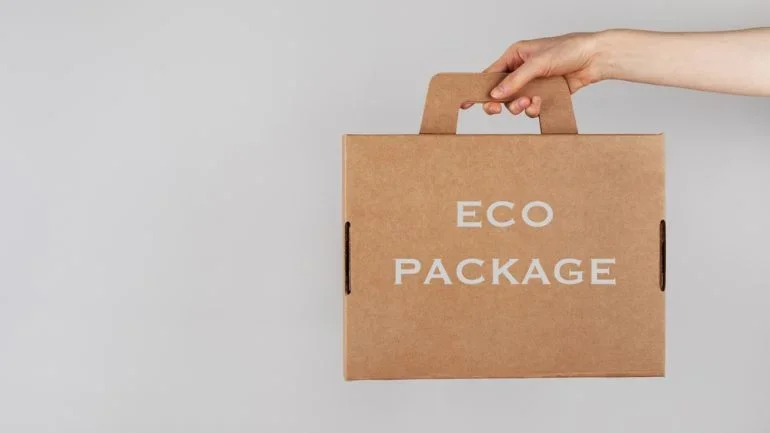Eco-friendly packaging is transforming the industry, with trends like biodegradable materials, minimalist design, and reusable solutions taking centre stage.

The packaging industry is undergoing a significant transformation as sustainability becomes a core focus for businesses and consumers alike.
Eco-friendly packaging is no longer just a buzzword but a genuine movement, shaping how companies approach their packaging choices. This shift is driven by growing environmental awareness, regulatory pressures, and a desire to minimise waste.
Let’s delve into the most prominent eco-friendly packaging trends that are shaping the future of the industry.
1. Biodegradable and compostable materials
One of the most impactful trends in eco-friendly packaging is the rise of biodegradable and compostable materials. Unlike traditional plastics, which can take hundreds of years to break down, biodegradable materials decompose naturally, leaving minimal impact on the environment.
Compostable packaging goes a step further, breaking down into non-toxic, organic matter that can enrich the soil.
Materials such as polylactic acid (PLA), derived from cornstarch, and mycelium, a type of fungus, are becoming popular alternatives to conventional plastics. These materials offer the same level of durability and protection as traditional packaging but with the added benefit of being environmentally friendly.
Brands are increasingly adopting these materials for packaging everything from food products to cosmetics, as they not only reduce waste but also appeal to eco-conscious consumers.
For businesses looking to implement biodegradable and compostable packaging, it’s important to consider the entire lifecycle of the product.
This means evaluating the sourcing of raw materials, the manufacturing process, and how the packaging will be disposed of or recycled after use. Doing so ensures that the packaging solution is genuinely sustainable and not just a temporary fix.
2. Minimalist packaging design
Minimalist packaging is gaining traction as companies aim to reduce their environmental footprint and cut costs. This trend focuses on using fewer materials, simplifying packaging designs, and eliminating unnecessary components, such as excess layers of wrapping or oversized boxes.
By adopting a ‘less is more’ approach, brands can reduce waste, lower shipping costs, and improve their overall sustainability.
Minimalist packaging often involves using recyclable or biodegradable materials, such as cardboard or paper, which are easily repurposed or decomposed.
This approach not only helps reduce the amount of waste ending up in landfills but also offers a cleaner, more modern aesthetic that resonates with today’s environmentally conscious consumers.
For businesses, implementing minimalist packaging involves reevaluating their existing packaging designs and finding ways to optimise them for efficiency.
This might mean redesigning products to fit into smaller packaging, using a single material that serves multiple purposes, or incorporating innovative folding techniques that eliminate the need for adhesives.
Not only does this reduce the environmental impact, but it can also result in cost savings, making it a win-win for both businesses and the planet.
3. Reusable and refillable packaging solutions
As the zero-waste movement gains momentum, reusable and refillable packaging solutions are becoming increasingly popular. Unlike single-use packaging, these solutions are designed to be used multiple times, significantly reducing the amount of waste generated.
This trend is particularly evident in industries such as cosmetics, personal care, and food, where brands are introducing products that can be refilled rather than replaced. For example, many beauty brands are now offering refillable containers for products like shampoo, conditioner, and lotions.
Consumers can purchase a durable container once and then buy refills in eco-friendly pouches or packaging, which not only cuts down on waste but also encourages brand loyalty.
Similarly, the food and beverage industry is exploring refillable packaging options, with supermarkets offering refill stations for items like grains, spices, and cleaning products.
Embracing reusable packaging solutions requires a shift in consumer behaviour, but it’s a change that many are willing to make in the pursuit of sustainability.
Businesses that adopt this trend can build a stronger relationship with their customers, as offering refillable options often conveys a sense of responsibility and care for the environment.
The takeaway
The shift towards eco-friendly packaging is more than just a passing trend; it’s a fundamental change in how businesses and consumers view packaging.
The rise of biodegradable and compostable materials, minimalist design, and reusable packaging solutions are just a few examples of how the industry is adapting to meet the demands of a more environmentally conscious market.
Brands that embrace these trends stand to benefit not only from reduced waste and lower costs but also from increased consumer loyalty and a stronger brand image.
As sustainability continues to be a driving force in purchasing decisions, adopting eco-friendly packaging solutions will be essential for companies looking to thrive in the future.
By staying ahead of these trends, businesses can contribute to a more sustainable world while meeting the evolving needs of their customers.
Source from Packaging Gateway
Disclaimer: The information set forth above is provided by packaging-gateway.com independently of Chovm.com. Chovm.com makes no representation and warranties as to the quality and reliability of the seller and products. Chovm.com expressly disclaims any liability for breaches pertaining to the copyright of content.





 Afrikaans
Afrikaans አማርኛ
አማርኛ العربية
العربية বাংলা
বাংলা Nederlands
Nederlands English
English Français
Français Deutsch
Deutsch हिन्दी
हिन्दी Bahasa Indonesia
Bahasa Indonesia Italiano
Italiano 日本語
日本語 한국어
한국어 Bahasa Melayu
Bahasa Melayu മലയാളം
മലയാളം پښتو
پښتو فارسی
فارسی Polski
Polski Português
Português Русский
Русский Español
Español Kiswahili
Kiswahili ไทย
ไทย Türkçe
Türkçe اردو
اردو Tiếng Việt
Tiếng Việt isiXhosa
isiXhosa Zulu
Zulu